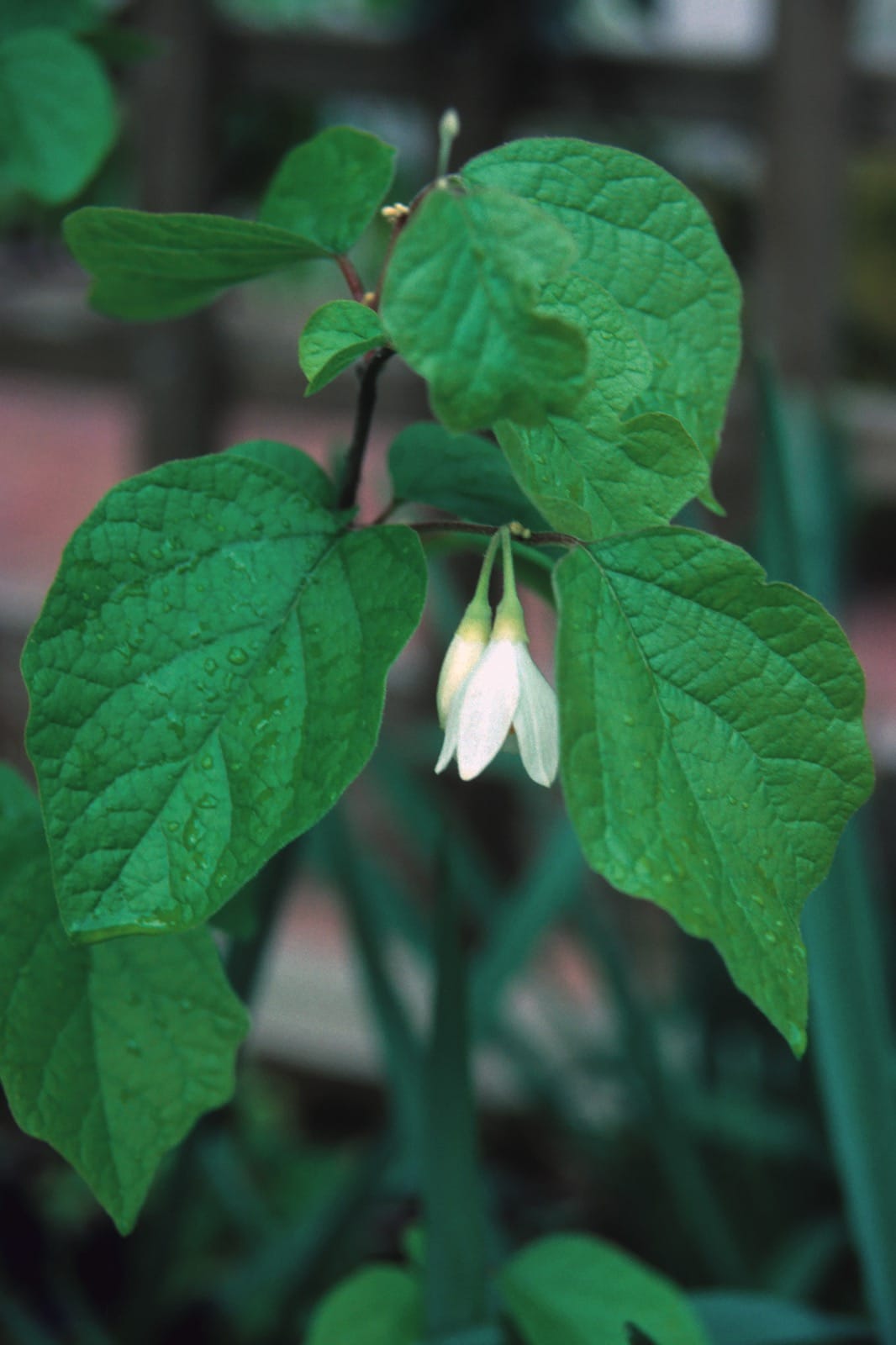Styrax platanifolius
Sponsor
Kindly sponsored by
Arabella Lennox-Boyd
Credits
John Grimshaw, Ross Bayton & Alan Elliott (2017)
Recommended citation
Grimshaw, J., Bayton, R. & Elliott, A. (2017), 'Styrax platanifolius' from the website Trees and Shrubs Online (treesandshrubsonline.
Genus
Infraspecifics
Other taxa in genus
- Styrax americanus
- Styrax calvescens
- Styrax confusus
- Styrax dasyanthus
- Styrax faberi
- Styrax formosanus
- Styrax grandifolius
- Styrax hemsleyanus
- Styrax hookeri
- Styrax japonicus
- Styrax limprichtii
- Styrax obassia
- Styrax odoratissimus
- Styrax officinalis
- Styrax redivivus
- Styrax serrulatus
- Styrax shiraianus
- Styrax suberifolius
- Styrax tonkinensis
- Styrax wilsonii
- Styrax wuyuanensis
Shrub to 3 m. Branchlets glabrous to densely covered in white stellate pubescence, sometimes somewhat glaucous, with a few brown stellate hairs at the base. Leaves papery, 4.5–9(–12) × 4–9(–11.5) cm, rounded to broadly ovate, upper surface glabrous or pubescent, lower surface glabrous or densely covered with white stellate hairs, five to six secondary veins on each side of the midrib, margins sometimes lobed or coarsely toothed towards the apex, apex rounded to obtuse; petiole 0.6–2 cm long. Inflorescences pseudoterminal, 2–5 cm long, with one to seven flowers; pedicels 0.4–0.9 cm long. Flowers ~1.5–2 cm long; calyx glabrous or densely covered in white stellate pubescence, teeth scattered, to 1 cm long; corolla to 2.1 cm, lobes five (to six), elliptic. Ovary densely covered in short stellate pubescence. Fruit globose, c.1 cm diameter, splitting by way of three valves, hairs greyish. (Fritsch 1997).
Distribution Mexico Coahuila, Tamaulipas United States Texas
Habitat Woodlands in desert mountains.
USDA Hardiness Zone 8
Conservation status Not evaluated (NE)
Styrax platanifolius exists as a number of scattered small populations in Texas and adjacent Mexico, with five subspecies having been described (Fritsch 1997). Of these, only subsp. mollis and subsp. youngiae appear to be in cultivation in our area, but the Texan subsp. platanifolius (which lacks any white stellate hairs), subsp. stellatus (Cory) P. W. Fritsch and subsp. texanus (Cory) P. W. Fritsch could conceivably appear in collections of native plants. Although its conservation status has not been evaluated based on IUCN criteria it is generally rather rare (Fritsch 1997).
subsp. mollis P.W. Fritsch
Subsp. mollis differs from subsp. youngiae by having soft stellate hairs that do not entirely cover the lower leaf surface, and from subsp. stellatus in that the arms of each stellate hair are up to 0.8–1 mm long (0.4 mm in subsp. stellatus), and in its disjunct range. Flowering April (Mexico). Fritsch 1997. Distribution MEXICO: Coahuila, Tamaulipas. Habitat Wooded canyons, between 1200 and 1400 m asl, in the northern Sierra Madre Oriental, and Chihuahuan desert mountains. USDA Hardiness Zone 8–9. Conservation status Not evaluated (IUCN). Rare (Fritsch 1997).
This plant is known in cultivation only from material collected in 1991 by John Fairey of Yucca Do Nursery, Hempstead, Texas, grown for example in the University of California Botanical Garden at Berkeley and the San Francisco Botanical Garden.
subsp. youngiae (Cory) P.W. Fritsch
Common Names
Young's Snowbell
In subsp. youngiae the lower surface of the leaf is completely covered and hidden by white stellate hairs, and the upper is more sparsely stellate-pubesccent (glabrous in subsp. texanus). Flowering April to May, fruiting July to September (Mexico). Fritsch 1997. Distribution MEXICO: Coahuila; USA: Texas. Habitat Mountain slopes and canyons, between 900 and 2000 m asl, in the Davis Mountains and eastern slopes of Chihuahuan desert mountains. USDA Hardiness Zone 7–8. Conservation status Not evaluated (IUCN). Rare (Fritsch 1997). Illustration Gonsoulin 1974; NT833.
Subsp. youngiae was cultivated for many years at the JC Raulston Arboretum, the longest survivor being an accession from Yucca Do Nursery obtained in 1993. This made a bushy plant of about 1.2 m tall, but was moved to avoid construction work and did not really recover (V. Tyson, pers. comm. 2008). When seen in 2006 it was a struggling shrub, and it has since been removed.
With their rather few flowers and short stature, these taxa are not among the cream of the genus, and are probably of botanical interest only, but considering their rarity in the wild as well as in cultivation any remaining plants should be carefully conserved.

